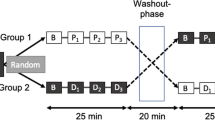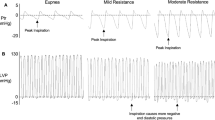Abstract
The conventional impedance cardiogram is a record of pulsatile changes in the electrical impedance of the chest with each heartbeat. The signal seems intuitively related to cardiac stroke volume. However doubts persist about the validity of stroke volume measurements based on electrical impedance. This paper presents a new electrical axis for impedance cardiography that is perpendicular to the conventional head-to-foot axis in an anterior-posterior direction. Dual chest and back electrodes are concentric, permitting tetrapolar technique. A relatively simple analytical model is developed, and this model is validated in a three-dimensional finite element model of current flow through the human chest. Three-dimensional simulations show predictable relationships between the fractional increase in anterior-posterior chest impedance and the ventricular ejection fraction (cardiac stroke volume/ventricular end-diastolic volume). Ejection fraction can be computed accurately with a roughly 30-fold increase in signal level compared to the conventional impedance cardiogram. Breathing causes only modest changes in the signal. When the axis of current flow is optimized, one can interpret the impedance changes during the cardiac cycle with greater confidence as noninvasive, beat-by-beat indicators of ventricular ejection fraction in a wide variety of clinical settings.










Similar content being viewed by others
Notes
The change in heart volume is the integral of the difference between emptying rate and filling rate of the heart during systole. If only the cardiac ventricles are within the volume sampled by impedance recording then the measured ejection fraction is the same as the true ventricular ejection fraction. If the cardiac atria are also sampled and we assume temporarily that the rate of venous return is nearly constant, then the amount of atrial filling during ventricular systole is the same as the mean flow, multiplied by the ejection time. In this case the sensed or effective ejection fraction is diminished by a factor of \( \left( {1 - t_{e} /T} \right) \), where t e = systolic ejection time, T = cycle time (1/cardiac frequency). In the remaining discussion ejection fraction and stroke volume are taken to mean the effective or net ejection fraction, including any sensed venous return to the atria. In a future computer based system times t e and T could be, if needed, obtained by waveform analysis of the front-to-back impedance cardiogram itself.
References
Nyboer J, Bango S, Barnett A, Halsey RH. Radiocardiograms: electrical impedance changes of the heart in relation to electrocardiograms and heart sounds. J Clin Invest. 1940;19:773 (abstract).
Tsadok S. The historical evolution of bioimpedance. AACN Clin Issues. 1999;10:371–84.
Kubicek WG, Witsoe DA, Patterson RP, Mosharrafa MA, Karnegis JN, From AHL. Development and evaluation of an impedance cardiographic system to measure cardiac output. Houston, Texas: National Aeronautics and Space Administration, Manned Spacecraft Center; 1967.
Geddes LA, Baker LE. Principles of applied biomedical instrumentation. 2nd ed. New York: Wiley; 1975.
Van De Water JM, Miller TW, Vogel RL, Mount BE, Dalton ML. Impedance cardiography: the next vital sign technology? Chest. 2003;123:2028–33.
Packer M, Abraham WT, Mehra MR, et al. Utility of impedance cardiography for the identification of short-term risk of clinical decompensation in stable patients with chronic heart failure. J Am Coll Cardiol. 2006;47:2245–52.
Raaijmakers E, Faes TJ, Goovaerts HG, Meijer JH, de Vries PM, Heethaar RM. Thoracic geometry and its relation to electrical current distribution: consequences for electrode placement in electrical impedance cardiography. Med Biol Eng Comput. 1998;36:592–7.
Wang DJ, Gottlieb SS. Impedance cardiography: more questions than answers. Curr Cardiol Rep. 2006;8:180–6.
Wang L, Patterson R. Multiple sources of the impedance cardiogram based on 3-D finite difference human thorax models. IEEE Trans Biomed Eng. 1995;42:141–8.
Patterson R, Wang L, McVeigh G, Burns R, Cohn J. Impedance cardiography: the failure of sternal electrodes to predict changes in stroke volume. Biol Psychol. 1993;36:33–41.
Van de Water JM, Mount BE, Barela JR, Schuster R, Leacock FS. Monitoring the chest with impedance. Chest. 1973;64:597–603.
Patterson RP, Wang L, Raza SB. Impedance cardiography using band and regional electrodes in supine, sitting, and during exercise. IEEE Trans Biomed Eng. 1991;38:393–400.
Critchley LA, Peng ZY, Fok BS, James AE. The effect of peripheral resistance on impedance cardiography measurements in the anesthetized dog. Anesth Analg. 2005;100:1708–12.
Miclavcic D, Pavselj N, Heart FX. Electrical properties of tissues. In: Akay M, editor. Wiley encyclopedia of biomedical engineering, vol. 6. New York: Wiley; 2006. p. 3578–89.
Bonjer FH, Van Den Berg J, Dirken MN. The origin of the variations of body impedance occurring during the cardiac cycle. Circulation. 1952;6:415–20.
Kosicki J, Chen LH, Hobbie R, Patterson R, Ackerman E. Contributions to the impedance cardiogram waveform. Ann Biomed Eng. 1986;14:67–80.
Raaijmakers E, Faes TJ, Goovaerts HG, de Vries PM, Heethaar RM. The inaccuracy of Kubicek’s one-cylinder model in thoracic impedance cardiography. IEEE Trans Biomed Eng. 1997;44:70–6.
Sakamoto K, Kanai H. Electrical characteristics of flowing blood. IEEE Trans Biomed Eng. 1979;26:686–95.
Author information
Authors and Affiliations
Corresponding author
Rights and permissions
About this article
Cite this article
Babbs, C.F. Anterior-Posterior Impedance Cardiography: A New Approach to Accurate, Non-Invasive Monitoring of Cardiac Function. Cardiovasc Eng 10, 52–65 (2010). https://doi.org/10.1007/s10558-010-9094-z
Published:
Issue Date:
DOI: https://doi.org/10.1007/s10558-010-9094-z




